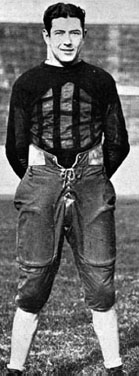Christmas Tales of Alabama (15 page)
Read Christmas Tales of Alabama Online
Authors: Kelly Kazek
Some genealogy sites state that the Crumps had five children. Records can be found for three daughters: Cintha Viola Crump, born 1874; Martha Crump, born 1879; and Mary Riggs Crump, born 1886. Mary Crump married Herman Darrah and lived until July 13, 1990, making her a few months older than her father was at the time of his death. Cintha, later written “Cynthia,” married Hillard Hollis and lived to the age of ninety-one.
Three years after the death of his first wife, Crump married Ella Wallis, who would die in 1942. Crump, who was named an honorary colonel by President Harry Truman, lived through six wars and twenty-three presidents, including Confederate president Jefferson Davis. Crump's life also spanned many changes, including the advent of automobiles, airplanes, indoor plumbing, movies, television and much more.
The Crump home was a favorite of children in the neighborhood, and Riggs was known as a hardworking Christian man with a cheerful disposition. He smoked a corncob pipe and worked in the fields up until his death.
During his life, Crump read the Bible seven times. In March 1951, he told the United Press that his favorite Bible verse was “Let not your heart be troubledâ¦In my Father's house are many mansions.”
He helped organize and build Refuge Baptist Church in Talladega County, where he was a deacon for seventy-one years. He was buried in adjoining Hall Cemetery. A historic marker at his grave site is inscribed: “Last Living Confederate Soldier in Alabama, Last Living Soldier That Witnessed the Surrender at Appomattox, VA.”
T
HE
N
EW
Y
EAR
'
S
G
AME
T
HAT
C
HANGED
H
ISTORY
In 1927, a handsome young man from Alabama would appear on the silver screen with rising star Joan Crawford in
Our Dancing Daughters
. In the era of silent films, no one knew that Johnny, a six-foot, one-inch actor with dark hair and a square jaw, was a country boy from Dothan, Alabama, with a thick southern drawl.
Soon, Johnny was starring alongside Norma Shearer, Mae West, Mary Pickford and Greta Garbo and, in his free time, playing polo with Spencer Tracy, duck hunting with Clark Gable and swimming with Johnny Weissmuller.
Back in Alabama, the young man already was a star. Born to Ed and Mattie Brown on September 1, 1904, Johnny Mack Brown was a standout on his high school football team, where he earned the nickname the “Dothan Antelope.” He was recruited, along with four of his brothers, to play for the University of Alabama.
On January 1, 1926, under Coach Wallace Wade, Johnny Mack and the Alabama team would make history, and the young man's life was forever changed.
The Game
Before 1926, no southern college football team had ever been invited to play in the Rose Bowl in Pasadena, California. In the game's twenty-four-year history, teams from the North, Midwest and West were considered powerhouses.
Although the Tigers of Auburn Universityâthen the Alabama Polytechnic Instituteâfinished the 1914 season undefeated, southerners still had a reputation developed in the aftermath of the Civil War for being less intelligent and less civilized than the rest of the country. In 1914, Auburn outscored opponents 193â0, a record that led to the team retroactively being named national champions; however, the university officially claims only Associated Press championships, a system that was not in use in 1914.
Following the 1925 season, the Washington Huskies, with a record of 10â0â1, were set to play for the championship. Rose Bowl officials invited other strong contenders, including Dartmouth, Yale and Colgate, to compete; however, because those colleges had recently been criticized for placing too much focus on athletics, they turned down the opportunity to play, hoping to send a message to boosters that academics were still the main reason for attending college.

Johnny Mack Brown was a star for the Alabama Crimson Tide in the 1926 Rose Bowl.
Courtesy of Encyclopedia of Alabama
.
When bowl officials extended the invitation to Alabama, which had completed its first undefeated season, people thought the match was laughable. Legendary coach Pop Warner told the press that Wade's team was “too light to stop that big Washington team.”
Ironically, the team Auburn beat to cinch the 1914 championship was Warner's Carlisle Indians.
But the invitation to the Rose Bowlâor any bowlâwas a first for a southern team. Alabama's Coach Wade knew the South's reputation was riding on the game. He told players that if they accepted the bid, they would be required to practice during the Christmas holiday. Everyone agreed. While the Alabama boys practiced and then boarded a train for the long trip to Pasadena, the Huskies practiced on their home field until game day.
At halftime, the pundits appeared to have accurately foretold the game: the Huskies were ahead 12â0. Then, in the third quarter, Alabama scored three touchdowns in rapid succession: the first by quarterback Allison “Pooley” Hubert and the next two by halfback Johnny Mack Brown. Washington responded, bringing the score to 20â19, with Alabama in the lead.
As the Huskies attempted to score in the final seconds, Brown made a spectacular tackle, winning the game for the southern underdogs.
On the train trip home, proud southerners, even Alabama's rivals, lined the route and cheered the team. Bands and well-wishers greeted the players on campus. Southern football teams suddenly were considered not only equal but also formidable opponents, foreshadowing the great tradition that college football would become in the South. Over the next twenty years, teams from the South played in the Rose Bowl thirteen times, although beginning in the 1940s, southern conferences were no longer eligible for the bowl.
An Alabama student commemorated the historic victory in the university's fight song, “Yeah, Alabama”:
Fight on, fight on, fight on, men!
Remember the Rose Bowl we'll win then!
Go, roll to victory, Hit your stride
,
You're Dixie's football pride, Crimson Tide!
A Star Is Born
Following Alabama's New Year's Day victory, Johnny Mack Brown's face graced the cover of Wheaties cereal boxes. Whether it was this visibility or one of the Hollywood elite he met while in Pasadena that led to his stardom is unclear, but by 1927, Brown was signed with Metro-Goldwyn-Mayer and soon was appearing in his first film.
In 1929, Brown played Mary Pickford's leading man in
Coquette
, her first talking picture. She won an Academy Award for the role. Brown's starring role in 1930's
Billy the Kid
helped solidify his reputation in Hollywood. MGM did not renew Brown's contract when new technology allowed filmmakers to add sound, perhaps because of his accent, but his career was far from over. His strong build and drawl made Brown perfect for the Westerns popular at the time. He would go on to make 168 films, 129 of which were westerns.
Brown married Cornelia “Connie” Foster, and the couple had four children. During the height of Johnny Mack's career, the family had a posh Beverly Hills home with a swimming pool and fraternized with legends such as Douglas Fairbanks and Spencer Tracy.
Brown died in 1974 at the age of seventy and was interred at Forest Lawn Cemetery in Glendale, California. His honors include College Football Hall of Fame, 1957; Alabama Sports Hall of Fame, 1969; Rose Bowl Hall of Fame, 2000; Alabama Stage and Screen Hall of Fame, 2004; World Gunspinning Hall of Fame, 2003; Golden Boot Award, 2004; and the Oklahoma Cowboy & Western Heritage Museum's Hall of Fame, 2008. He also has a star on the Hollywood Walk of Fame.
About the Author

Kelly Kazek is managing editor of the
News Courier
in Athens, Alabama. In her more than two decades as a journalist, she has won more than 130 national and state press awards. She is the author of
Fairly Odd Mother: Musings of a Slightly Off Southern Mom
, a collection of her syndicated humor columns;
Hidden History of Auburn
;
Forgotten Tales of Alabama
;
Forgotten Tales of Tennessee
;
A History of Alabama's Deadliest Tornadoes: Disaster in Dixie
; and
Images of America: Athens and Limestone County
. She lives in Madison, Alabama, with her daughter, Shannon; their beagle, Lucy; and cats Mad Max, Luvey and Charley.
Visit us at